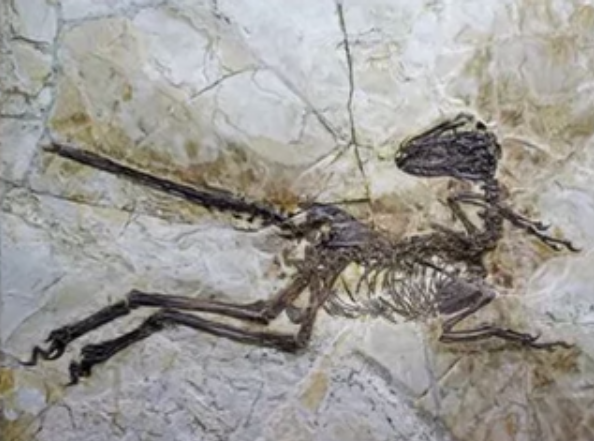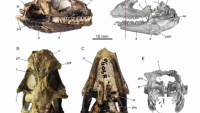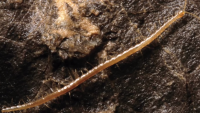Dinosaur: Remarkably Preserved Fossil Of ‘Feathered Poodle From Hell’ Found
| Quadey Humile | | Jul 17, 2015 08:07 PM EDT |
(Photo : Youtube) A team of scientists from the University of Edinburgh and the Chinese Academy of Geological Sciences, has unearthed a remarkably well-preserved and almost complete fossil of a densely-feathered dinosaur.
A team of scientists from the University of Edinburgh and the Chinese Academy of Geological Sciences has unearthed a remarkably well-preserved and almost complete fossil of a densely-feathered dinosaur.
Dubbed as a "fluffy feathered poodle from hell," the Zhenyuanglong suni is considered a close cousin of the famous velociraptors, The Sydney Morning Herald reported.
Like Us on Facebook
"This is the largest feathered dinosaur [discovered] with a complex set of wings, made up of layers of quill-pen-type feathers, " study co-author and University of Edinburgh paleontologist Steve Brussatte said. "It was about six and a half feet long and weighed 44 pounds, or so. Not a giant compared to T. rex or Brachiosaurus, but very big for a dinosaur with huge wings."
Discovered in Liaoning Province in northeastern China, where thousands of other feathered dinosaur fossils have been previously found, the new skeleton was reportedly preserved through volcanic activity- Pompei style.
"Volcanoes would occasionally erupt and bury these animals, turning them to stone, like a prehistoric Pompeii," Brusatte said. "They were buried so quickly, in the right chemical environment, that soft tissues like feathers didn't have time to decay, so they were often preserved."
Zhenyuanlong is a totally different and new species unlike the other feathered dinosaurs previously discovered in the area and something that scientists have never seen in their 20 years of work at the site.
The new dinosaur is said to be a member of the family Dromaeosuaridea, which consisted of small-to-medium-sized feathered meat eaters that lived in the Cretaceous period 125 million years ago. But unlike previously discovered feathered dinosuars, Zhenyuanlong is the only one to possess complex, multi-layered bird-like wings with feathers like those used to make quill pens, CNet has learned.
"We do have larger feathered dinosaurs, like the close T. rex cousin Yutyrannus, which is 26 to 29 feet long," Brussatte went on to explain. "But these are more primitive dinosaurs, and they have more primitive feathers. They merely have simple hair-like feathers, which don't look much like most modern bird feathers. Only later in dinosaur evolution did the feathers become larger and more complex, take the shape of a quill pen (with a central shaft and many branches from the shaft), and then gather into wings."
But despite its large wings, the raptor's cousin's ability to fly is still in question because it has extremely short arm bones.
"Although there are some minor differences, in general, the wings are basically indistinguishable from those of hawks or vultures or other living birds," he explained as per FOX News. "But, there is one main difference - the bony part of the wing. The feathers are huge, but the arms are short. If you just looked at the skeleton, you would say that there is no way something with such short arms could fly."
The creature's very huge wings despite its extremely short arms could have possibly allowed it to fly in short distances.
"Maybe Zhenyuanlong had some basic aerial abilities. Maybe it could glide or fly for very short distances, although there is no way it could fly with the same type of sustained, muscle-driven, powered flight of today's birds," said Brussatte. "Or maybe it used its wings for display, or to brood its eggs. There are many possibilities and not one good answer."
The study is published in the journal Scientific Reports.
©2015 Chinatopix All rights reserved. Do not reproduce without permission
EDITOR'S PICKS
-

Did the Trump administration just announce plans for a trade war with ‘hostile’ China and Russia?
-

US Senate passes Taiwan travel bill slammed by China
-

As Yan Sihong’s family grieves, here are other Chinese students who went missing abroad. Some have never been found
-

Beijing blasts Western critics who ‘smear China’ with the term sharp power
-

China Envoy Seeks to Defuse Tensions With U.S. as a Trade War Brews
-

Singapore's Deputy PM Provides Bitcoin Vote of Confidence Amid China's Blanket Bans
-

China warns investors over risks in overseas virtual currency trading
-

Chinese government most trustworthy: survey
-

Kashima Antlers On Course For Back-To-Back Titles
MOST POPULAR
LATEST NEWS
Zhou Yongkang: China's Former Security Chief Sentenced to Life in Prison

China's former Chief of the Ministry of Public Security, Zhou Yongkang, has been given a life sentence after he was found guilty of abusing his office, bribery and deliberately ... Full Article
TRENDING STORY

China Pork Prices Expected to Stabilize As The Supplies Recover

Elephone P9000 Smartphone is now on Sale on Amazon India

There's a Big Chance Cliffhangers Won't Still Be Resolved When Grey's Anatomy Season 13 Returns

Supreme Court Ruled on Samsung vs Apple Dispute for Patent Infringement

Microsoft Surface Pro 5 Rumors and Release Date: What is the Latest?













